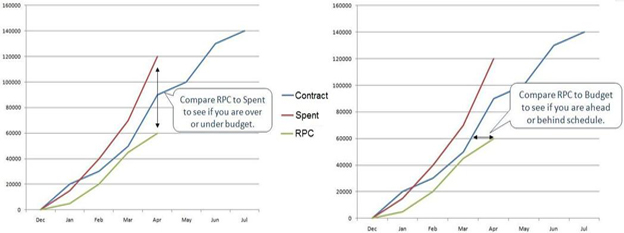
by Brian Siefkes, Deltek Systems Inc.
“If you’re not using Earned Value Analysis, you’re just flying by the seat of your pants.”
– PSMJ
You may have heard in various classes or webinars that you’ve attended that Earned Value Analysis (EVA) is a great way to track and manage your projects. It’s one of the many tools that industry experts tell you can boost your project’s profitability.
But if EVA is that beneficial, why do so few firms actually use it?
One common reason for its low usage is the difficulty in getting the right data presented in a useful manner. With today’s accounting and project management software for engineering and architecture firms, those issues are quickly becoming a thing of the past.
When we talk about EVA in the Professional Services industry, we’re talking about the relationship between a project’s contract amount, spent (earned or burn rate) amount and the project’s reported percent complete (RPC). When you compare these three items against your estimated project timeline, you start to paint a vivid picture of where your project stands
The EVA data is most commonly displayed using a three line graph (see example below). For a project manager or principal, this graph can be a valuable tool for quickly determining if a project is on time and on budget.
The best part about Earned Value Analysis is if you’re using an project management and accounting software, then you probably have all of the necessary data – it just happens to be in various places. In any AE project management software, before you ever start work on a job, you should enter your contract amounts, and budget the project down to the phase level. Once your contract is set and your project is active, you begin capturing your time and expenses, spent amount.
The final piece of the EVA puzzle is the one that is used the least: Reported Percent Complete at the phase level. Not all software programs are built to capture the RPC so some firms will track it outside of their project management software if they track it at all. RPC is a critical piece of EVA. It should come directly from the project manager and be updated at least once a week or as predetermined milestones are met.
If you have all of these elements, then you have everything you need to create an Earned Value Analysis graph.
In a perfect world as your project nears completion, you would see your contract, spent and RPC values all follow the same path. The reality is that projects will change and evolve while you’re working on them, which can make tracking and management difficult if not impossible. This is where the EVA graphs are most useful.
You can compare your RPC vertically to your spent value to see where your project stands in terms of budget to actual. You can gauge whether or not your project is on schedule by comparing your RPC horizontally to your contract amount. When you analyze your EVA at the project or phase level, you can easily take the guesswork out of determining your overall project status.
While most firms have all of the EVA data available, the difficulty comes in putting the graphs together and updating them regularly. If you are using older or generic accounting software for AE firms, then you will most likely have to create the EVA graphs using Microsoft Excel. If that’s the case, then you will also need to create a process for manually entering the spent and RPC values and timelines as they change.
That tends to be more work than an administrative staff wants to take on, especially if they are already stretched thin, as many architecture and engineering firms are these days. A more integrated solution you might consider is Ajera software, which offers a built-in progress report that gives you real-time, up-to-date Earned Value Analysis at the project and phase level – at any time with just the click of a mouse.
In today’s economy, managing projects with maximum efficiency to ensure your projects are as profitable as possible couldn’t be more important. Gone are the days of too many jobs and not enough staff; leaking money away on your projects will surely drown your engineering or architecture firm.
Successfully using Earned Value Analysis can help plug the holes and identify small problems before they become major headaches.
To request a demo contact us.

Deltek Project Nation Newsletter
Subscribe to receive the latest news and best practices across a range of relevant topics and industries.


